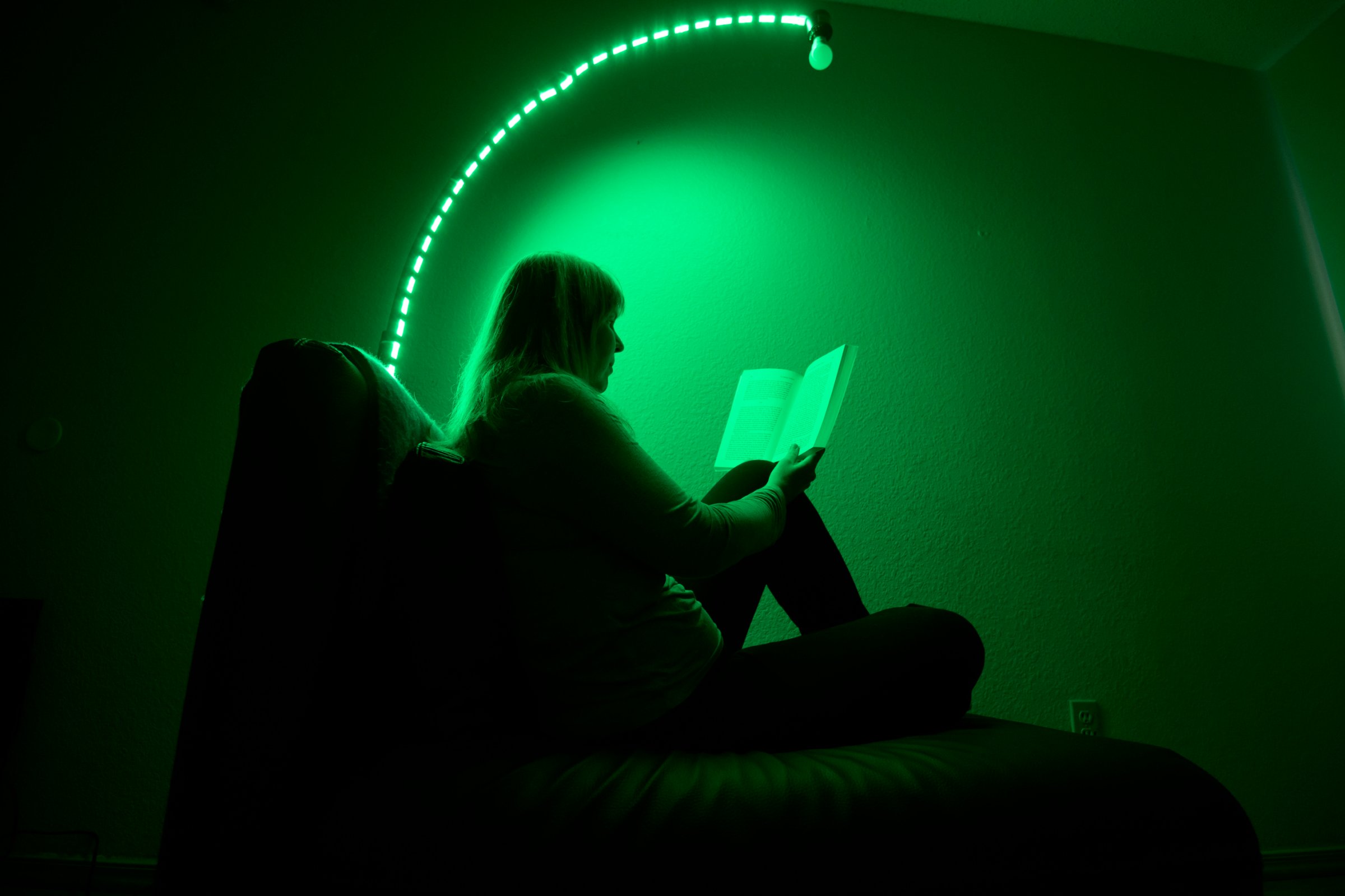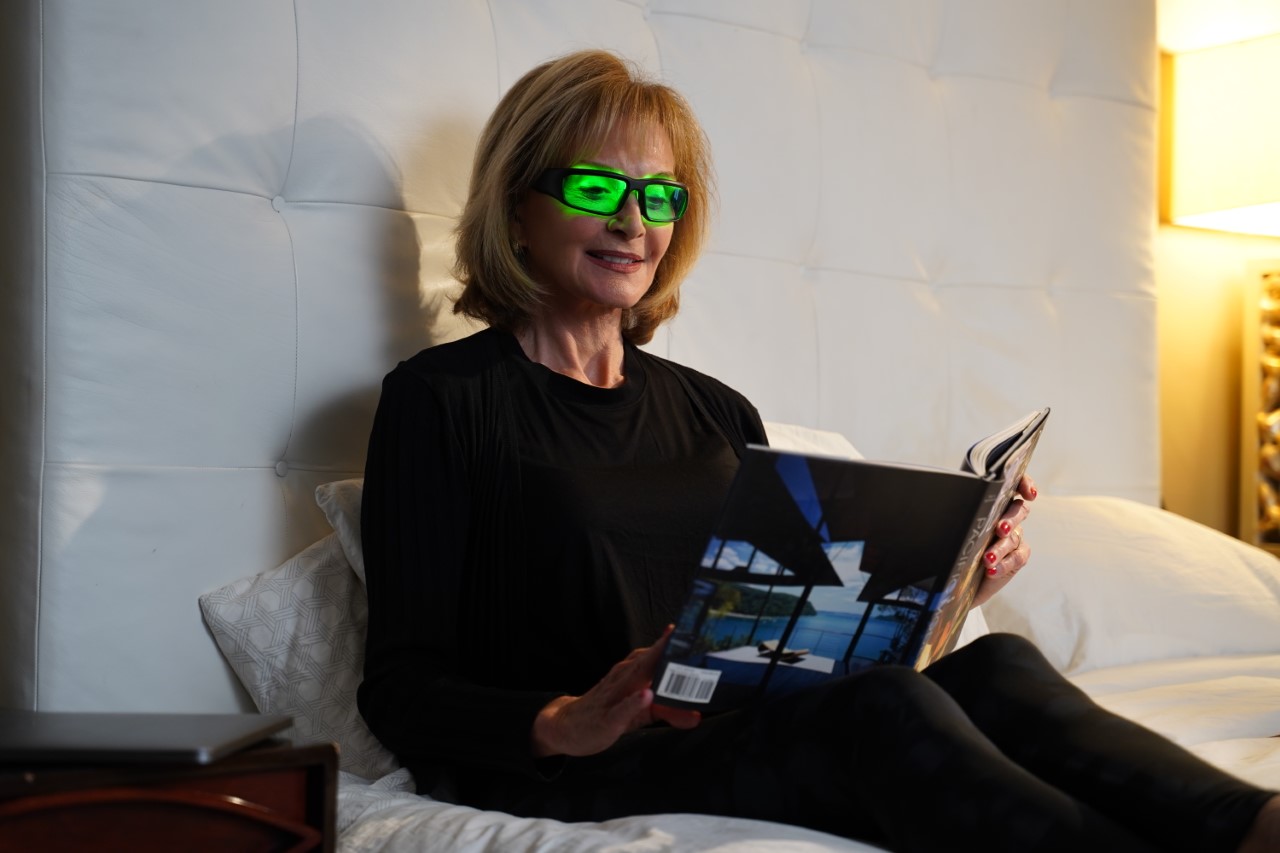
About 20% of adults in the U.S.—more than 50 million people—have chronic pain. Though the causes are many, including arthritis, cancer, musculoskeletal skeletal disorders, migraines, fibromyalgia, and more, solutions are limited.
Over-the-counter analgesics often do little. Physical therapy, massage, and acupuncture help sometimes—but not always. Prescription opioids may provide short-term relief, but at a price. At least three million Americans are currently addicted to the drugs.
Researchers are now exploring another potential alternative that is safe, affordable, and comes with few or no side effects and no risk of addiction: green light exposure. Though the science is young and the research is by no means conclusive, in recent years, studies have found that exposing people to light across the green wavelength—either by having them sit in a dark room illuminated by green LED light strips or by giving them green-tinted glasses to wear—can reduce both their severity of pain and the frequency of episodes of migraines, fibromyalgia, and chronic musculoskeletal pain. It can also relieve the anxiety and fear associated with chronic pain.
In a study presented Oct. 23 at the annual meeting of the American Society of Anesthesiologists in New Orleans, Dr. Padma Gulur, vice chair of the department of anesthesiology at Duke University, reported on an experiment she conducted in which 34 fibromyalgia patients were assigned to wear tinted glasses of different shades, four hours per day for two weeks. Ten of the patients wore glasses with blue lenses, 12 wore clear ones, and another 12 wore green. At the end of the study period, the people who wore green glasses were four times likelier than those in either of the other two groups to report that their anxiety over their pain had declined, as had their reliance on opioids.
Read More: Inside Ibogaine, One of the Most Promising and Perilous Psychedelics for Addiction
Gulur used commercially available glasses for the study and tested each with a spectrophotometer to ascertain exactly which wavelength of green light each pair produced. She also tested each person’s pair of eyeglasses at the end of the study to confirm which person got which wavelength. “What struck us the most was that at the end of the study, the patients were so pleased with the results, they didn’t want to return the green glasses,” she says.
Though small, Gulur’s study is not the only one of its kind. At the University of Arizona, Dr. Mohab Ibrahim, professor of anesthesiology, neurosurgery, and pharmacology; along with Laurent Martin, assistant professor of anesthesiology; and other colleagues have published half a dozen papers in the past four years demonstrating the power of green light to reduce pain. In one, published in 2020 in the journal Cephalalgia (which means “headache”), the investigators recruited 29 migraine sufferers and exposed them to one to two hours of green LED lights—which the university provided people to set up in their homes—every day for 10 weeks in an otherwise dark room. The treatment reduced headache days by 70% in people suffering from episodic migraines compared to their baseline frequency of headaches, and by nearly 60% in those suffering from more frequent, chronic migraines. (The group exposed to white LEDs experienced no change.) In another paper, published the following year in the journal Pain Medicine, Ibrahim recruited 21 fibromyalgia patients, conducted similar therapy and found that people who reported their pain as an eight out of 10 when they were exposed to white light dropped their rating to below five when they were exposed to green.
“There are neural pathways that start from the eyes and can be traced back to several brain regions,” says Ibrahim, who also works as medical director of the Comprehensive Pain and Addiction Center at the Banner-University Medical Center. “Some of these regions are heavily involved in pain modulation.” Through a mechanism that’s not yet fully understood, the green light appears to interrupt this connection, providing relief without medication, or at least not as much.
“This is such a simple approach,” Ibrahim says. “There’s still some skepticism, and rightfully so. When you make an extraordinary claim, you have to have extraordinary evidence. But the more studies and research that get funded, the closer we get to reaching a critical mass of evidence that says, OK, something is really happening here.”
Breaking the cycle
For Jennifer Dinardo, 64, a Tucson retiree who previously worked in the hospitality industry, the trouble began when she was 18 and went skateboarding after, as she describes it, drinking more wine than she put in the spaghetti sauce she was making that evening. She took a spill and landed face first on the sidewalk, breaking her nose and fracturing a bone in her neck. The pain was acute, and as she was being treated, the doctor responded promptly with pills.
“He said, ‘Here, Take these. These will make you feel better,’” she recalls.
They did—for a while. But that one bad night led to complications including fibromyalgia and migraine headaches, and eventually required surgery to fuse two disks in her neck. Her pain turned chronic, and she took powerful pain relievers for years.
“I tried everything,” Dinardo says. “Massage therapy, stretching exercises, tai chi. And multiple times, I ended up back with the prescription in my hand.”
Read More: Why Overdose Deaths Skyrocketed After Opioid Prescriptions Dropped
Finally, in 2020, she showed up at the Comprehensive Pain and Addiction Center just as Ibrahim was beginning one of his trials with green light therapy. “He said, ‘Would you be interested in this study?’’’ she recalls. “I said, ‘I will do anything.’”
For the next 70 days, Dinardo would spend two hours every day in a room in her home lit only by the green LEDs, reading and listening to music to pass the time. After 30 days, her chronic pain began to fade. Not long after, she quit using all painkillers, and she has been free of any medications since she began the treatment two years ago. She kept the LEDs, and while she doesn’t use them every day any longer, she turns them on whenever her neck pain, headaches, or fibromyalgia flare.
“You can feel the difference,” she says. “It really is amazing.”
How does green light relieve pain?
Scientists don’t yet know exactly why green light seems to help painful conditions like fibromyalgia and headaches, but they have some ideas. Gulur believes the answer may lie in green light’s ability to trigger melanopsin, a light-sensitive neurotransmitter present in the eye that’s responsible for regulating pupil dilation and contraction. Melanopsin also interacts with the periaqueductal gray matter, a structure in the upper brainstem that plays a role in processing pain. She speculates that melanopsin may activate an inhibitory pathway that doesn’t process pain, but rather, shuts it down. And not just any old green light will do the trick, she’s found, but rather specific frequencies of it.

“You would think it would be the peak of the green wavelength—absolute green—that would be most effective,” she says. “But what we found for chronic pain was that it’s the lower wavelengths and the higher wavelengths—more towards the ends of the green spectrum—that seem to be helping patients.” That limits people’s options to try this therapy out for themselves, since simply buying any green glasses available in a store does not guarantee the proper wavelength, which can only be tested with a spectrophotometer.
For now, this is just a theory. But Gulur is currently developing a new study in which the brains of pain patients wearing green glasses will be scanned with functional magnetic resonance imaging (fMRI) to see if the inhibitory pathway indeed exists.
Ibrahim and his colleagues are looking at other brain regions that play a role in processing pain, especially the rostral ventromedial medulla (RVM), which is also located in the brain stem. A particular type of brain cells, known as GABAergic neurons, produce a protein known as c-Fos; this protein is a marker for neuronal reactivity in many brain regions, including the RVM. In animal studies, rats exposed to green light produced less c-Fos, suggesting reduced activity of the GABAergic neurons modulating the pain pathway.
“We evaluated the amount of GABAergic cells that were expressing c-Fos, and we found that green light was lowering their output,” Ibrahim says. “Overall, the light reduces the activity of the cells, which, if they were stimulated, would promote pain.”
Read More: 5 Ways to Cope with Migraines at Work
In other studies, Ibrahim has looked at the front end of the inhibitory pathway—the cells in the eye that react to green light and get the analgesic process rolling. In one 2022 study, published in Clinical Medical Insights: Case Reports, he found that green light had pain-relieving effects even in a color-blind patient who also suffered from chronic headaches. That study might seem to suggest that nothing more than the placebo effect is at work, in which the person expects to experience pain relief and so does. But Ibrahim says otherwise. The two principal types of cells in the eye that process light and color are known as cones and rods, for their signature shapes, and it is the cones that malfunction in color-blindness. But there is a third type, too, known as intrinsically photosensitive retinal ganglion cells, and these are not affected in color-blind people. It is these cells, Ibrahim believes, that might be the ones responsible for pain relief.
“It’s one of our hypotheses,” he says, “that the effect of green light goes at least in part through these photosensitive cells.” Gulur agees with this idea, pointing out that those same cells also contain melanopsin, which in her models plays such a central role in pain relief.
Far more research in humans is needed. And not even its proponents believe that green light therapy will entirely replace other forms of pain treatment—including pharmacological ones. “Will it ever replace traditional medicine?” says Ibrahim. “I don’t think so. That’s not the intent. The intent is to decrease the reliance on medications right away because realistically speaking, these are all tools.”
Still, green light treatment is already going commercially mainstream. Multiple manufacturers sell green LED lighting systems online and market them for pain relief, though there is no guarantee that the wavelength of green used in the products will be effective.
To try to create something that is, Ibrahim and Luxxon Therapeutics are combining the glasses and LED method: building green LEDs directly into the frame of a pair of glasses so that they shine in the eyes of the user during treatment sessions.
Green light exposure checks so many therapeutic boxes, Ibrahim says. “The first one is safety, then efficacy, then price, then adherence,” he says. It’s that last one—the adherence, or the patients’ commitment to sticking with the treatment—that might be the most telling. “Chronic pain patients will do almost anything to get rid of the pain,” Ibrahim says.
Dinardo agrees. “Just sitting in that room with the green light,” she says, “is such a change for me—and such a blessing.”
Correction, October 31: The original version of this story misstated the role the c-Fos protein plays in pain. It is a marker for the pain circuit having been completed in the brain; it does not complete the circuit itself.
More Must-Reads from TIME
- Cybersecurity Experts Are Sounding the Alarm on DOGE
- Meet the 2025 Women of the Year
- The Harsh Truth About Disability Inclusion
- Why Do More Young Adults Have Cancer?
- Colman Domingo Leads With Radical Love
- How to Get Better at Doing Things Alone
- Michelle Zauner Stares Down the Darkness
Write to Jeffrey Kluger at jeffrey.kluger@time.com